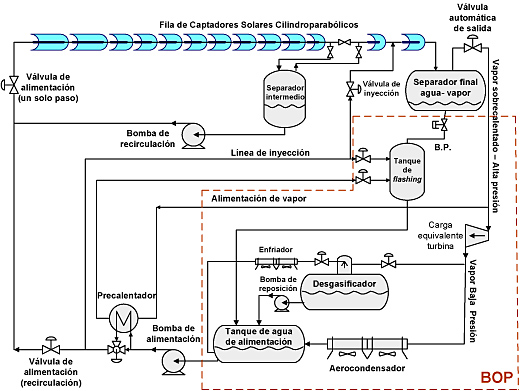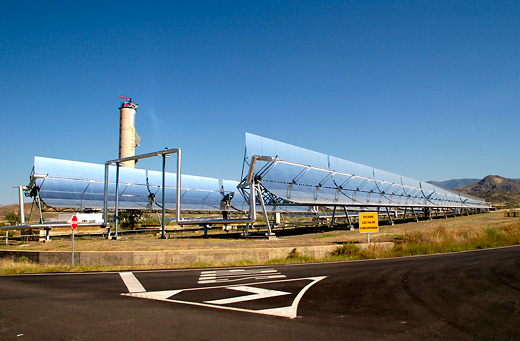

DISS
This test facility was erected and put into operation in 1998 for experimenting with direct generation of high-pressure-high temperature (100 bar/400ºC) steam in parabolic-trough collector absorber tubes. It was the first facility built in the world where two-phase-flow water/steam processes in parabolic-trough collectors could be studied under real solar conditions.
The facility consists of two subsystems, the solar field of parabolic-trough collectors and the balance of plant (BOP). In the solar field, feed water is preheated, evaporated and converted into superheated steam at a maximum pressure of 100 bar and maximum temperature of 400ºC as it circulates through the absorber tubes of a 700-m-long row of parabolic-trough collectors with a total solar collecting surface of 3,838 m2. The system can produce a nominal superheated steam flow rate of 1 kg/s. In the balance of plant, this superheated steam is condensed, processed and reused as feed water for the solar field (closed loop operation).
In 2012, within the Project DUKE, three additional parabolic-trough collectors were installed in the solar field and all the absorber tubes were replaced by new ones, to increase up to 500ºC the temperature of the superheated steam produced, enabling to generate direct steam at 100bar and 500ºC.

Facility operation is highly flexible and can work from very low pressures up to 100 bar. It is also equipped with a complete set of valves allowing the solar field to be configured for Recirculation (perfectly differentiated evaporation and superheating zones), for Once-Through (the intermediate water-steam separator and the recirculation pump located in the solar field are not used in this operatin mode) and in Injection mode (feed water is injected in different points along the collector row).
The facility is provided with a wide range of instrumentation for full system monitoring (flow rates and fluid temperatures in the various zones of the solar field, pressure drops in collectors and piping, temperature and thermal gradients in the cross sections of the absorber tubes, etc.) and a data acquisition and process control system which has a database where 5-s process data are recorded 24 hours a day.

Among the capacities associated with this facility are the following:
- Component testing for parabolic-trough collector solar fields with direct steam generation in their receiver tubes (receivers, ball joints or flexholes, water-steam separators, specific instrumentation, etc.)
- Study and development of control schemes for solar fields with direct steam generation
- Study and optimization of the operating procedures that must be implemented in this type of solar field
- Thermo-hydraulic study of two-phase of water/steam in horizontal tubes with non-homogeneous heat flux